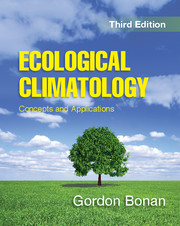Book contents
- Frontmatter
- Dedication
- Contents
- Preface
- 1 Ecosystems and Climate
- Part I The Earth System
- Part II Global Physical Climatology
- Part III Hydrometeorology
- Part IV Biometeorology
- Part V Terrestrial Plant Ecology
- 18 Plant Strategies
- 19 Populations and Communities
- 20 Ecosystems
- 21 Soil Biogeochemistry
- 22 Vegetation Dynamics
- 23 Landscapes and Disturbances
- 24 Global Biogeography
- Part VI Terrestrial Forcings and Feedbacks
- Appendix
- Index
- Plate section
- References
22 - Vegetation Dynamics
from Part V - Terrestrial Plant Ecology
Published online by Cambridge University Press: 05 November 2015
- Frontmatter
- Dedication
- Contents
- Preface
- 1 Ecosystems and Climate
- Part I The Earth System
- Part II Global Physical Climatology
- Part III Hydrometeorology
- Part IV Biometeorology
- Part V Terrestrial Plant Ecology
- 18 Plant Strategies
- 19 Populations and Communities
- 20 Ecosystems
- 21 Soil Biogeochemistry
- 22 Vegetation Dynamics
- 23 Landscapes and Disturbances
- 24 Global Biogeography
- Part VI Terrestrial Forcings and Feedbacks
- Appendix
- Index
- Plate section
- References
Summary
Chapter Summary
Ecosystems are not static entities, but rather are in a state of continual change. Disturbances that create clearings initiate vegetation dynamics that varies according to life history patterns and competition among plants for light, water, and nutrients. Some species grow fast and are short lived. These plants are ephemeral features in the landscape, using a life history that allows them to rapidly colonize and dominate recently disturbed patches. These denuded patches occur through processes endogenous to the landscape such as the death of a large tree that creates a gap in the canopy or through exogenous disturbances such as wildfires and hurricanes. Over time, these early dominants give way to slower growing, longer-lived species. The rise and fall of taxa is part of the life cycle of communities and ecosystems, a process ecologists call succession. It creates pattern to the arrangement of vegetation across the landscape related to disturbance history. The prevailing scientific view emphasizes succession as a population process. It is a result of the physiology, morphology, and life history of species operating in a gradient of environmental change. The differential growth, survival, and colonizing ability of species adapted to the various environments encountered during community development create shifting patterns of dominance. Individual species colonize where conditions are favorable, die out when the environment is no longer favorable, and grow in company with other species with similar environmental requirements.
Population Dynamics
Population density changes over time through the birth, growth, and death of its members. The classic description of population growth is the logistic growth equation:
where N is density at time t, r is an intrinsic rate of population growth determined as the difference between birth and death rates, and K is carrying capacity. The term describes exponential population growth in the absence of limiting resources. However, resources are rarely unlimited, and the resources available to individuals become scarcer as population density increases. At high density, competition among individuals for available resources limits population growth. The term reduces the rate of growth as population density approaches the maximum number of individuals the environment can support (i.e., the carrying capacity of the environment). This equation has an S-shape or logistic form, with exponential growth at low density declining to zero growth (i.e., constant density) at high density.
- Type
- Chapter
- Information
- Ecological ClimatologyConcepts and Applications, pp. 376 - 399Publisher: Cambridge University PressPrint publication year: 2015



